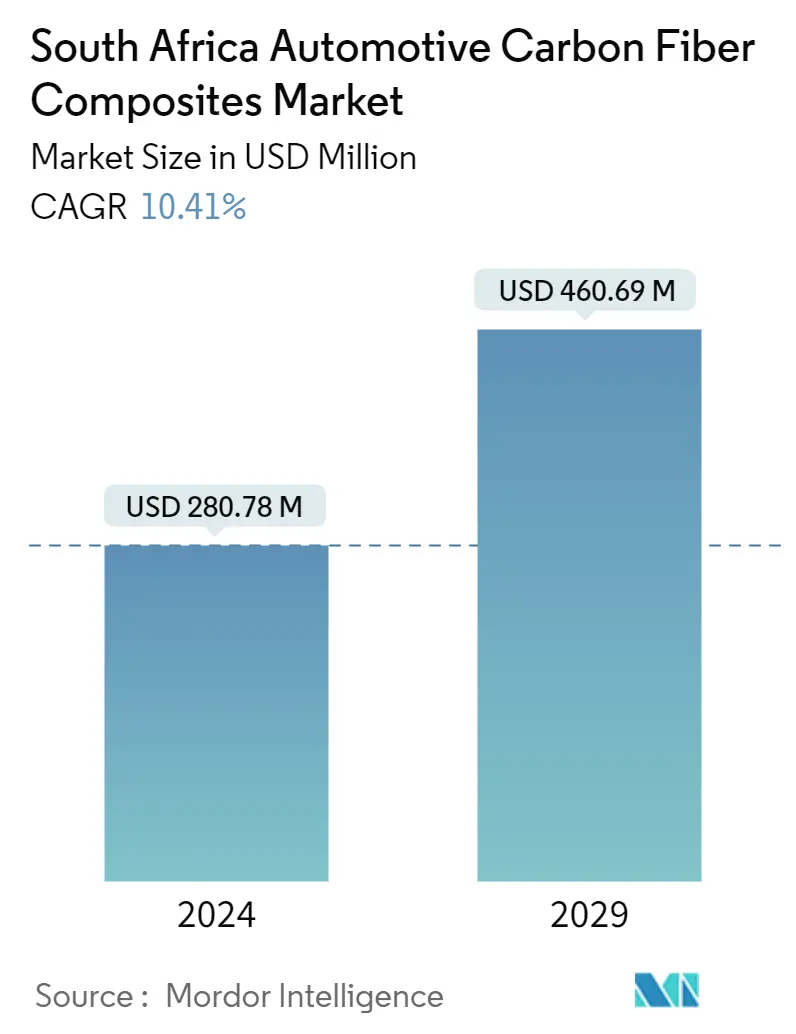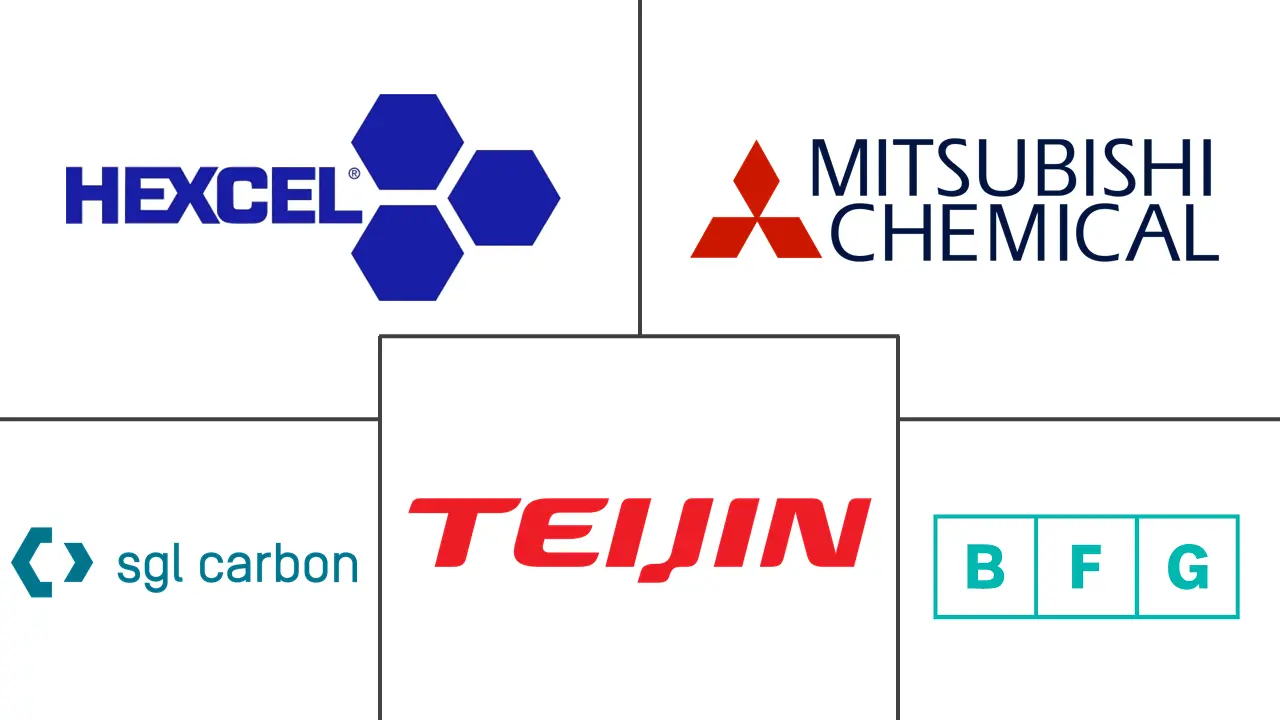Market Size of South Africa Automotive Carbon Fiber Composites Industry

| Study Period | 2019 - 2029 |
| Base Year For Estimation | 2023 |
| Market Size (2024) | USD 280.78 Million |
| Market Size (2029) | USD 460.69 Million |
| CAGR (2024 - 2029) | 10.41 % |
| Market Concentration | Medium |
Major Players
*Disclaimer: Major Players sorted in no particular order |
South Africa Automotive Carbon Fiber Composites Market Analysis
The South Africa Automotive Carbon Fiber Composites Market size is estimated at USD 280.78 million in 2024, and is expected to reach USD 460.69 million by 2029, growing at a CAGR of 10.41% during the forecast period (2024-2029).
Over the long term, an increasing number of automobile production and sales, rising per capita disposable income of consumers, and growing demand for availing lightweight components to reduce vehicle weight, which ultimately leads to lower carbon emissions, will serve as major determinants for the growth of the South African automotive carbon fiber composites market.
- According to the International Organization for Motor Vehicle Manufacturers (OICA), new commercial vehicle registrations in South Africa reached 165.8 thousand units in 2022 compared to 146.3 thousand units in 2021, representing a Y-o-Y growth of 13.3% between 2021 and 2022.
- Heavy truck production in South Africa stood at 30,249 units in 2022 compared to 26,969 units in 2021, recording a Y-o-Y growth of 12% between 2021 and 2022.
Carbon fiber is a lightweight material with high-strength characteristics that can be designed for enhanced performance in automotive applications. It offers improvement in structural, functional, or cosmetic properties. To make vehicles lighter, cleaner, safer, and more cost-effective, the leading carbon fiber suppliers are responding to the needs and expectations of the vehicle OEMs, system suppliers, and customers. One of the major headwinds for the industry is its low recyclability and higher cost than traditional composites, which leads to hiking the prices of vehicles.
However, with rapid enhancement in carbon fiber technology, which makes it suitable for manufacturing various vehicle parts, and the increasing demand for automakers to replace their existing metal parts with carbon fibers, a massive demand for this composite type is expected in the coming years. Many car companies, such as BMW, Audi, GM, Honda, and Polestar, have established mass production agreements with carbon fiber material producers. They are investing in their processes to support low-cost carbon fiber manufacturing.
South Africa Automotive Carbon Fiber Composites Industry Segmentation
Automotive carbon fiber composites are a specific type of composite material made by combining carbon fiber with a resin, such as vinyl ester or epoxy, to create vehicle components, such as chassis, that have higher performance properties than the individual materials alone.
The South African automotive carbon fiber composites market is segmented by vehicle type, application, and manufacturing process. By vehicle type, the market is segmented into passenger cars and commercial vehicles. By application, the market is segmented into structural assembly, powertrain components, interior, exterior, and others (underbody, etc.). By manufacturing process, the market is segmented into compression molding, injection molding, resin transfer molding, and others (over molding, etc.).
The report offers market size and forecasts for the automotive carbon fiber composites in value (USD) for all the above segments.
| By Vehicle Type | |
| Passenger Cars | |
| Commercial Vehicles |
| By Application | |
| Structural Assembly | |
| Powertrain Component | |
| Interior | |
| Exterior | |
| Others (Underbody, Etc.) |
| By Manufacturing Process | |
| Compression Molding | |
| Injection Molding | |
| Resin Transfer Molding | |
| Others (Oven Molding, Etc.) |
South Africa Automotive Carbon Fiber Composites Market Size Summary
The South African automotive carbon fiber composites market is poised for significant growth over the forecast period, driven by increasing automobile production and sales, rising disposable incomes, and a growing demand for lightweight vehicle components. These factors are crucial as they contribute to reducing vehicle weight and, consequently, carbon emissions. The market is characterized by the adoption of carbon fiber, a material known for its lightweight and high-strength properties, which enhances the performance and efficiency of vehicles. Despite challenges such as higher costs and low recyclability compared to traditional composites, advancements in carbon fiber technology and the strategic shift by automakers towards using these materials in place of metal parts are expected to drive demand. This trend is further supported by the increasing urbanization in South Africa, which is boosting the demand for passenger vehicles.
The market landscape is competitive, with numerous international and domestic players like Hexcel Corporation, Mitsubishi Chemical Group, and SGL Carbon SE actively investing in innovation and capacity expansion to meet the growing demand. The government's initiatives to promote electric vehicles and reduce carbon emissions align with the market's trajectory, as carbon fiber composites are increasingly used in the production of exterior body parts for these vehicles. The establishment of manufacturing facilities and partnerships, such as Stellantis's collaboration with the Industrial Development Corporation, underscores the commitment to enhancing production capabilities in South Africa. As the market evolves, the introduction of advanced carbon fiber materials and strategic acquisitions, like Mitsubishi Chemical Group's acquisition of CPC SRL, are expected to further strengthen the supply chain and meet the rising demand from automakers.
South Africa Automotive Carbon Fiber Composites Market Size - Table of Contents
-
1. MARKET DYNAMICS
-
1.1 Market Drivers
-
1.1.1 Increasing Demand for Lightweight and Energy-efficient Automotive Components to Foster the Growth of the Target Market
-
-
1.2 Market Restraints
-
1.2.1 High Manufacturing and Processing Cost of Composites
-
-
1.3 Industry Attractiveness - Porter's Five Forces Analysis
-
1.3.1 Threat of New Entrants
-
1.3.2 Bargaining Power of Buyers/Consumers
-
1.3.3 Bargaining Power of Suppliers
-
1.3.4 Threat of Substitute Products
-
1.3.5 Intensity of Competitive Rivalry
-
-
-
2. MARKET SEGMENTATION (Market Size in Value - USD)
-
2.1 By Vehicle Type
-
2.1.1 Passenger Cars
-
2.1.2 Commercial Vehicles
-
-
2.2 By Application
-
2.2.1 Structural Assembly
-
2.2.2 Powertrain Component
-
2.2.3 Interior
-
2.2.4 Exterior
-
2.2.5 Others (Underbody, Etc.)
-
-
2.3 By Manufacturing Process
-
2.3.1 Compression Molding
-
2.3.2 Injection Molding
-
2.3.3 Resin Transfer Molding
-
2.3.4 Others (Oven Molding, Etc.)
-
-
South Africa Automotive Carbon Fiber Composites Market Size FAQs
How big is the South Africa Automotive Carbon Fiber Composites Market?
The South Africa Automotive Carbon Fiber Composites Market size is expected to reach USD 280.78 million in 2024 and grow at a CAGR of 10.41% to reach USD 460.69 million by 2029.
What is the current South Africa Automotive Carbon Fiber Composites Market size?
In 2024, the South Africa Automotive Carbon Fiber Composites Market size is expected to reach USD 280.78 million.

